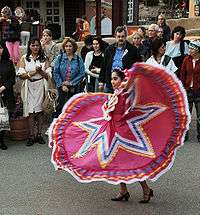Baile Folklorico
Baile folklórico, literally "folkloric dance" in Spanish, is a collective term for traditional Mexican in dances that emphasize local folk culture with ballet characteristics - pointed toes, exaggerated movements, highly choreographed. As mentioned below, baile folklórico owes its inception to Amalia Hernandez. Baile folklórico differs from danzas and regional bailes. "Folk dances", that is, "dances that you will find in the villages, not on stage" were researched and disseminated by Alura Angeles de Flores. A good rule of thumb is if the woman raises her hands about her head (thus showing her legs), it is folklórico. Each region in Mexico, the Southwestern United States and Central American countries is known for a handful of locally characteristic dances.
Mexico
Dances

The state of Jalisco, for example is especially known for its jarabe Tapatio, son and el baile de los sonajeros which accompany its famous mariachi. One of the most popular songs is "La Negra". The state of Jalisco. The state of Guerrero is known for its sintesis and tixtla. Michoacán is known for its huetamo and “Historia del Traje de la Mujer Michoacana,” a dance which depicts a local folktale Alegria, 1995.[1] Though the dances differ from region to region, the basic steps and style of dance are similar. Traditional bailes in Vera Cruz are characterized by a basic set of steps called zapateados which involve percussive heel-stomping.
Costumes
Costumes in the southwest United States are characterized by denim and western shirts while costumes of the Federal District of Mexico reflect a stronger traditional Spanish influence and those of the Yucatán reflect indigenous traditions.[1] In the folk dances of Northern Mexico, men generally wear black pants with galas on each side of the leg, accented with a red tie and belt and a black wide-brimmed hat. The woman wear tighter fitting and shorter skirts and either white or black boots. The costumes from Jalisco entails the women to wear brightly colored ruffled skirts trimmed with ribbons whose colors are local signifiers, shoes with heavy clog-like heels and ornate hair pieces. Shoes vary in color but usually they are either black, white, or red, depending on the song and region. For the region of Veracruz, the women wear beautiful white dresses that are full of lace. They use white shoes, and a small apron with a bandana that hangs off the side of the dress. Whether the woman is married or not determines what side the bandana will hang and which side the floral head piece will lie. Married means that it would be on the left side and single would hang on the right. Sinaloa, from the coastal region, wear lighter and more colorful dresses. The people of the Americas typically wear darker colors as a show of mourning for the dead.[2]
Popularity
Amalia Hernandez pioneered baile folklorico in the 1950s with her establishment and leadership of the Ballet Folklorico Mexico. Additionally, she founded a school in Mexico City for the study and practice of classical and folkloric dance techniques.[3]
Prior to its rise in popularity among student and community groups, bailes folklóricos were (and currently are) performed as a part of large parties or community events. The mariachi musicians generally stand in a line at the back of the performance space and perform without written musical notation, while the dancers perform in couples in front of the mariachis. Nowadays there are both private and public Folklorico groups that get together and compete, for example the USA Ballet Folklorico Nationals.
Central America
Central America has many Bailes Folkloricos. One typical dance from Costa Rica is the Punto Guanacasteco.
References
- 1 2 "Chismes de la Farandula de Famosos y Celebridades". Alegria.org. Retrieved 2012-05-23.
- ↑ The JVC/Smithsonian Folkways video anthology of music and dance of the Americas: Volume 6 Central and South America. Dir. and Prod. Ohta, Horoaki, Katsumori Ichikawa, Yuji Ichihashi and Nihon Bikuta Kabushiki Kaisha. Videocassette. Multicultural Media, 1995.
- ↑ Past Cowan Event - Ballet Folklorico de Mexico de Amalia Hernandez Archived September 4, 2006, at the Wayback Machine.
- Loeffler, Jack. La Música de los Viejitos: Hispano Folk Music of the Rio Grande del Norte. Albuquerque: University of New Mexico Press, 1999.
External links
| Wikimedia Commons has media related to Baile folklórico. |
- Baile Folklorico at DMOZ
- Mexican Dancing - Folk Dance
- Dances and videos
- Folklorico Sources & Information
- Website